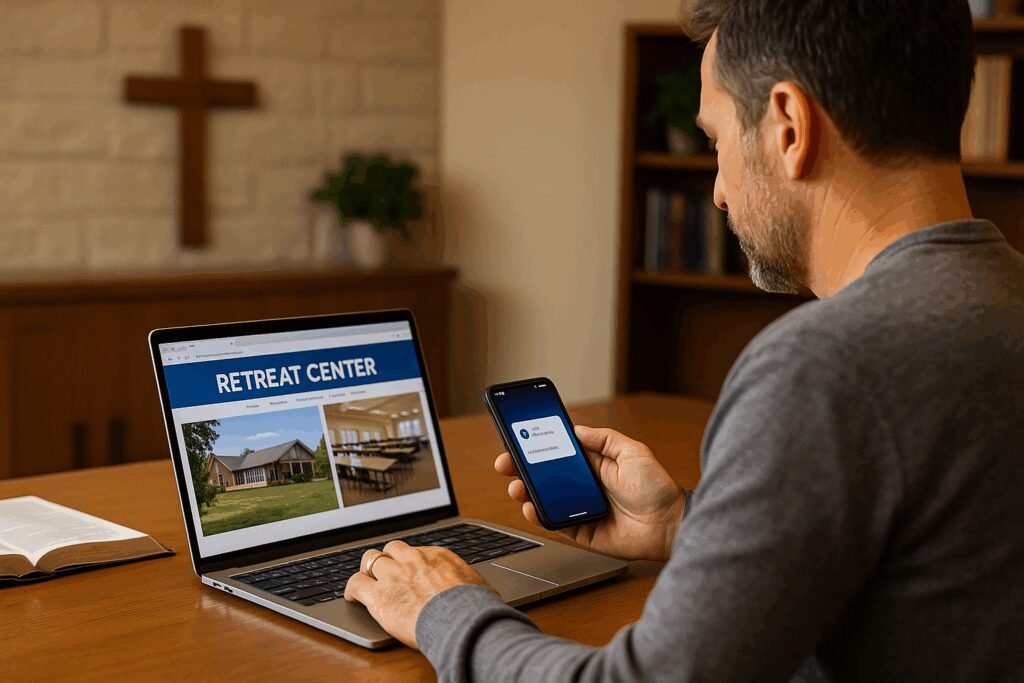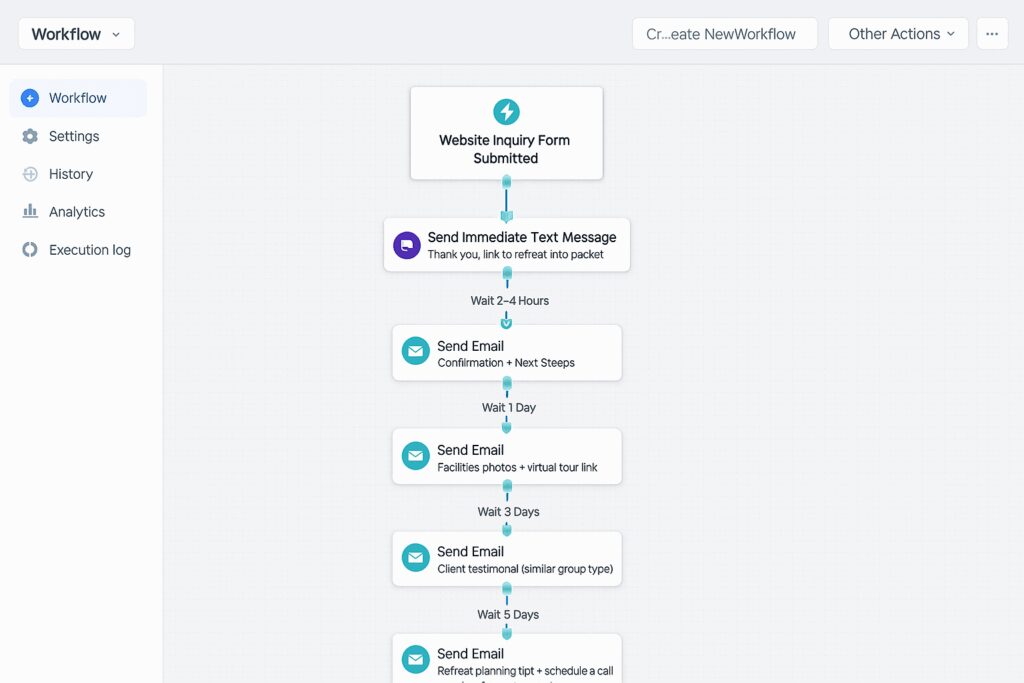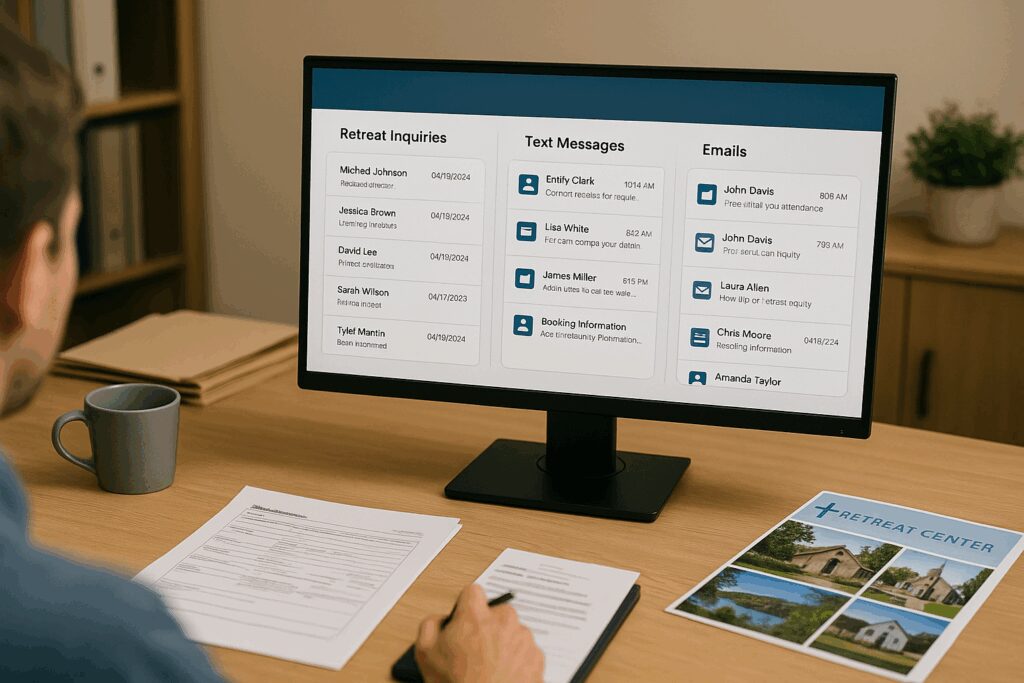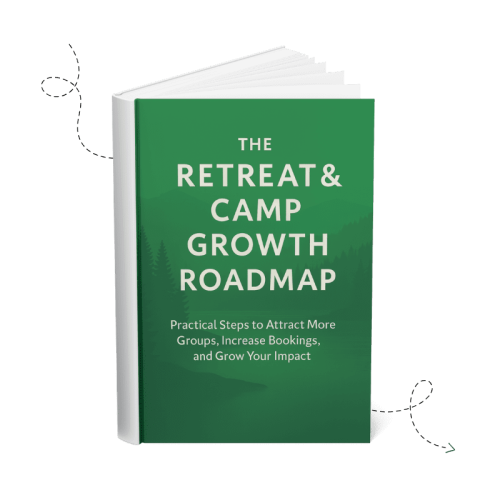Retreat & Camp Growth Roadmap Focus Area: Build Nurture Workflows
Introduction
Automated lead nurture workflows help retreat centers turn initial inquiries into confirmed bookings by responding faster, building trust, and staying top-of-mind throughout the group leader’s decision-making process.
When a group leader inquires about hosting a retreat, their excitement and interest are often at their peak. Yet many retreat centers take one to two days to respond, and then only follow up sporadically. In that time, momentum is lost, questions go unanswered, and opportunities slip away.
The reality is that many churches and groups don’t make a decision quickly. They often begin by gathering several options, then take weeks—or even months—of internal meetings and discussions before narrowing things down. Each passing week is an opportunity for new questions, hesitations, or competing options to enter the picture.
Research shows that leads responded to within 5 minutes are about 21× more likely to convert than those contacted after 30 minutes (Chili Piper). And yet, more than half of companies still take five or more days to respond to new leads (CallPage). That gap creates a wide-open opportunity for retreat centers that put rapid, consistent nurturing systems in place.
Automated lead nurture workflows—using email and text messages alongside personal phone calls—help you bridge that gap. They keep information flowing, position your center as a proactive partner, and ensure you remain top-of-mind throughout the decision-making journey. Done well, they improve guest experience, build trust, and increase booking conversions.
Why This Focus Area Matters
Every retreat inquiry represents a real person who is balancing schedules, budgets, and expectations. A fast, thoughtful response communicates, “We value you and your group.” It’s the first taste of hospitality you offer, and it sets the tone for the rest of the guest journey.
From a stewardship perspective, nurture workflows make sure no inquiry is wasted. If you’ve invested in Christian camp marketing, SEO for retreat centers, or word-of-mouth referrals, every inquiry is precious. Automated workflows help you capture more value from each one by:
- Responding within minutes rather than days. Groups contacted within 5 minutes are more than 20 times more likely to book compared to those left waiting (Chili Piper).
- Closing the gap where many competitors falter—since over half of organizations take five or more days to respond (CallPage).
- Dripping out helpful information that answers common questions.
- Anticipating objections about price, availability, or amenities before they arise.
- Keeping your center top-of-mind during the group leader’s decision-making process.
The result: group leaders feel cared for, staff are less overwhelmed, and your conversion rates climb.
Is This an Area You Need to Focus on Right Now?
Reflect honestly on these questions:
- Do you respond to new inquiries within the first hour?
- Do you follow up with prospects multiple times if they don’t respond right away?
- Do you use both email and SMS as part of your follow-up strategy?
- Do you have a missed call text-back process in place?
- Do your follow-up messages provide value—such as resources or planning tips—or do they only “check in”?
If you answered “no” to any of these, this focus area can help you bring greater clarity, alignment, and impact to your outreach.
Putting This Focus Area into Practice
Building nurture workflows is not about replacing personal connections—it’s about making sure no guest falls through the cracks while freeing your staff to focus on higher-value conversations. Think of it as setting the table: automation handles the basics, and your team steps in to deepen the relationship.
To make this easier to digest, we’ll break the workflows into categories: rapid response, core workflow examples, long-term nurture, education-driven campaigns, and technology tools.
Respond Rapidly (Minutes, Not Days)
Speed is one of the most overlooked factors in retreat marketing. A group leader who inquires today may also contact three or four other centers. If you wait a day or two to respond, chances are high they’ve already moved on. Automation bridges that gap by sending an instant text or email confirming receipt of their inquiry.
- Example workflow: Website form submission → immediate text (“Thanks for reaching out—we’re excited to learn about your retreat!”) → confirmation email with details on what to expect next.
Guests who hear back within minutes feel seen and valued. And when responses land within that crucial 5-minute window, the odds of eventually booking skyrocket.

Core Workflow Examples
Website Inquiry Workflow
One of the most common scenarios retreat centers face is a new inquiry through the website. This is often the very first touchpoint with a guest, and it sets the tone for the entire relationship. If you wait too long to respond, a group leader may assume you’re not interested, or they may move forward with another center that replies faster. An automated workflow ensures that every inquiry is acknowledged right away, while also providing a structured follow-up plan in the days that follow.
- Trigger: Website inquiry form submission.
- Step 1 (Immediate): Text — “Thanks for reaching out! We’re excited to learn about your retreat needs. Here’s a link to our retreat information packet so you can start exploring options.”
- Step 2 (Same day, within 2–4 hours): Email — Confirmation that their inquiry was received, outlining what happens next.
- Step 3 (1 day later): Email — Highlight facilities with photos and a virtual tour link.
- Step 4 (3 days later): Email — Share a client testimonial from a similar group type.
- Step 5 (5 days later): Email — Provide retreat planning tips and encourage scheduling a call.
This workflow ensures inquiries don’t sit idle. By delivering timely responses across multiple channels, you keep the group engaged, reduce the chance of losing them to another option, and set the stage for meaningful conversations.

No-Contact Workflow
Sometimes an inquiry comes in, but after the first outreach attempt there’s no response. This doesn’t always mean the lead isn’t interested—they may be busy, distracted, or waiting to gather more information before replying. A no-contact workflow ensures that your center stays in front of them with helpful touchpoints, while also showing persistence and attentiveness.
- Trigger: Inquiry submitted but no reply after initial outreach.
- Step 1 (2 days after inquiry): Text — “We’d love to learn more about your retreat needs. Here’s a quick link to schedule a call at your convenience.”
- Step 2 (4 days after inquiry): Email — Highlight unique property amenities.
- Step 3 (7 days after inquiry): Email — Address a common objection (e.g., pricing flexibility) and invite questions.
By providing consistent follow-up, you demonstrate that your center values the guest’s interest. Even if they don’t reply immediately, your messages keep your retreat center top-of-mind and give them multiple opportunities to reconnect when they are ready.
Post-Call Nurture Workflow
After a phone call with a prospect, it’s tempting to assume that the relationship is “handled.” But in most cases, the group leader is not the only decision-maker—they’ll need to take your information back to a committee or team. A post-call nurture workflow ensures that the momentum from your conversation continues, equipping the leader with resources and reminders they can share internally.
- Trigger: Completed sales call with prospect.
- Step 1 (Immediate): Email — Thank them for the call, recap main points, and attach a retreat planning packet they can share with decision-makers.
- Step 2 (2 days later): Email — Share a testimonial from a similar group.
- Step 3 (4 days later): Text — “Just checking in—do you have any questions as you discuss with your team?”
This workflow reinforces your professionalism while making it easy for group leaders to advocate for your retreat center. By staying engaged after the call, you increase the likelihood that the group will come back with a decision in your favor.
Missed Call Workflow
Few things are more discouraging than seeing a missed call from a prospective guest—and not hearing back from them again. In reality, many guests won’t try calling twice. A missed call workflow addresses this by sending a quick, friendly text response that keeps the door open and invites them to re-engage on their terms.
- Trigger: Incoming call goes unanswered.
- Step 1 (Immediate, within 1–2 minutes): Text — “Sorry we missed your call! We’d love to connect. Here’s a link to schedule a time that works best for you.”
- Step 2 (Next day): Text — “Still hoping to connect about your retreat needs. Can I answer any quick questions by text?”
This workflow turns a potentially lost lead into an opportunity for reconnection. By responding quickly and offering flexible ways to continue the conversation, you show attentiveness even when your team isn’t immediately available by phone.
Re-Engagement Workflow
Sometimes a lead goes completely quiet for weeks. Instead of writing them off, a re-engagement workflow allows you to circle back with new energy and value. This shows that you haven’t forgotten about them and gives them an easy way to re-engage without pressure.
- Trigger: Lead has been inactive for 30+ days.
- Step 1: Email — “Still planning your retreat? Here are a few open dates you may want to consider.”
- Step 2 (1 week later): Email — Share a testimonial about a successful retreat.
- Step 3 (2 weeks later): Text — “We’d love to host your group when the time is right. Would you like me to send you some seasonal package options?”
This workflow gently nudges prospects back into conversation. Even if they’re not ready to commit immediately, these reminders keep your retreat center in the running and position you as proactive and consistent.
Long-Term Nurture Workflow
Not every inquiry turns into a booking within the first month. Some group leaders are in the very early stages of planning, or they may need multiple church committee meetings before making a decision. A long-term nurture workflow helps you stay present without being pushy, ensuring they don’t forget about you as time passes.
- Trigger: Lead has not booked within 30–60 days of initial inquiry.
- Step 1 (30 days after inquiry): Email — Send a retreat planning checklist as a helpful resource.
- Step 2 (45 days after inquiry): Email — Share a client story or testimonial about a successful retreat.
- Step 3 (60 days after inquiry): Email — Highlight seasonal opportunities (e.g., fall retreats, off-peak pricing, weekday discounts).
- Step 4 (90 days after inquiry): Text — Friendly reminder: “Still planning your retreat? We’d love to explore options that fit your group’s needs.”
This workflow keeps your retreat center in front of prospects who are still deciding, while gently positioning you as the most helpful and proactive option.
Automated Lead Nurture Campaigns as Education and Trust-Builders
Regardless of the workflow, the guiding principle of nurturing is to add value with every touchpoint. Guests are more likely to engage when messages answer questions, anticipate objections, or equip them with planning tools. Each communication should feel like a service, not just a reminder.
Examples of value-driven touches include:
- Testimonials that build social proof.
- A retreat planning checklist to position you as a partner.
- A transparent breakdown of pricing and policies.
- Unique features of your property (chapel, team-building activities, recreation).
- Seasonal booking ideas to inspire decisions.
Instead of “checking in,” value-driven messages steadily build trust and confidence, making prospects more likely to choose your retreat center when they are ready to book.
Use a CRM with Automation to Keep Everything Connected
Having automated workflows is powerful, but they reach their full potential only when paired with a CRM (Customer Relationship Management system). A CRM with automation capabilities ensures that every lead interaction—whether it’s a website inquiry, a phone call, or a text—is tracked in one place. This creates visibility for your whole team, prevents duplicate or missed efforts, and makes sure the guest’s journey feels seamless. Without a CRM, automation can become scattered, leading to inconsistent guest experiences.
LeadHub CRM is a recommended solution for retreat centers because it integrates workflows with your sales pipeline, website forms, and even your camp management system. With LeadHub:
- Workflows can be triggered by inquiries, pipeline stage changes, or missed calls.
- Communication stays unified across email, text, and phone.
- Your team can see the full history of interactions with each guest in one place.
- Cost is much lower than comparable platforms such as HubSpot
- Has unique built-in features such as AI agents, reputation management, and business listing management
- Integrates easily with thousands of other software platforms
Instead of juggling multiple systems, your staff gains clarity and confidence. Automation doesn’t replace your team—it empowers them to focus on meaningful conversations while ensuring no lead is left behind.

Lead Nurture Workflow Planning Worksheet
To make this practical, we’ve developed a worksheet to help you map out triggers, timing, and communication channels. It also includes space to identify what value each step should provide, ensuring your workflows are guest-centered and mission-aligned.
📥 Download the Lead Nurture Workflow Planning Worksheet
By using this worksheet, your team can move from general ideas to specific, actionable workflows that fit your retreat center’s unique process. It will help you clarify your follow-up strategy, keep guests engaged at every step, and ensure no inquiry falls through the cracks.
Mini Case Study
A Christian retreat center we worked with used to rely solely on personal follow-up by their sales coordinator, often waiting two or more days to reply to new inquiries. By then, some prospects were hard to reach or had already booked elsewhere.
We helped them implement a 5-step nurture series:
- Immediate automated response thanking them for the inquiry, outlining next steps, and linking to a retreat information packet.
- Four follow-up emails, each spaced a few days apart, highlighting answers to common questions—pricing, policies, amenities, and highlighting unique features of the property and their services for retreat organizers.
The results:
- Inquiries were acknowledged immediately, improving guest confidence.
- Prospects were more responsive to personal outreach.
- Sales conversations were more focused because prospects had already consumed helpful content.
This shift turned inconsistent follow-up into a consistent, guest-friendly process that boosted responsiveness and bookings.
Putting It All Together
The difference between a retreat center that responds in days and one that responds in minutes isn’t just technology—it’s the difference between lost leads and a full calendar.
And the data backs it up: groups contacted within 5 minutes are 21× more likely to convert than those who wait even half an hour (Chili Piper). On the other hand, more than 55% of organizations take five or more days to respond (CallPage). That means your retreat center can gain a significant edge simply by moving from delayed responses to same-day—or ideally same-hour—follow-up.
Key takeaways:
- Respond within minutes using automation.
- Use multiple channels—calls, emails, texts—to connect effectively.
- Build workflows for common scenarios: inquiries, missed calls, no-contact leads, post-call follow-ups, re-engagement, and long-term nurture.
- Use automated lead nurture campaigns to educate, address objections, and inspire confidence.
- Use a CRM with automation (like LeadHub CRM) for seamless integration and visibility.
By weaving nurture workflows into your guest services process, you create a culture of attentiveness that begins before the retreat and carries all the way through. This consistency not only fills your calendar but also strengthens your reputation as a partner that groups can trust.
Ready to Take the Next Step?
Nurture workflows can transform your guest experience and your bottom line. With automation, you can serve leads more effectively, free up your staff, and book more retreats with less stress.
If you found this helpful, here are four great next steps to continue your journey:
🧭 Move to the Next Focus Area: Streamline Pipeline Management
Learn how to automate emails and texts to manage retreat logistics and rebooking.
[Read Next Focus Area Article]
📘 Download the Retreat & Camp Growth Roadmap eBook
Get the full 3-stage system we use to help retreat centers and camps grow with clarity and purpose.
[Download the eBook]
🌱 Learn More About How We Help Retreat Centers & Camps
We’re a Christian-owned digital marketing agency that helps retreat centers and camps grow attendance, bookings, and impact through practical strategies rooted in clarity and stewardship.
[See How We Can Help]
🤝 Schedule a Free Discovery Call
Want help applying this to your unique situation? Let’s talk. We’ll explore where you are now, where you want to go, and how to take the next faithful step.
[Book a Discovery Call]
You don’t have to figure this out alone. Let’s build something meaningful—together.
Frequently Asked Questions
1. Why is fast follow-up so important for retreat inquiries?
Leads go cold quickly. A group leader who inquires today may submit requests to three or four centers. The first to respond with warmth and clarity often wins the booking. Research shows that groups contacted within 5 minutes are 21× more likely to convert than those contacted after 30 minutes (Chili Piper).
2. What if my team doesn’t have time to respond within the hour?
That’s where automation helps. Even a simple text response saying “We got your request and will reach out soon” makes a difference and buys your team time. Over time, automation takes pressure off your staff and reduces missed opportunities.
3. How do nurture workflows improve conversion rates?
By staying in touch regularly, answering questions, and overcoming objections through content, workflows build trust and confidence. This shortens the decision-making process and increases the likelihood of a booking. Tracking engagement rates and conversion metrics also helps refine what works best.
4. Will automation feel impersonal to guests?
Not if done thoughtfully. Workflows should use warm, conversational language that reflects your center’s mission and voice. Automation ensures no guest feels ignored, while still leaving space for your team to step in personally.
5. How should email and SMS be used together?
Use text for quick touches (confirmations, reminders, missed call responses) and email for more detailed communication (retreat options, planning tips, follow-ups). Together they create a balanced guest experience and accommodate different preferences.
6. What is a missed call workflow, and why does it matter?
If a prospect calls and no one answers, they may not call back. A missed call text-back workflow sends an immediate, friendly message to re-engage them, turning a lost opportunity into a live lead. This simple automation can recover inquiries you otherwise never would have heard from again.
7. How does a CRM with automation support nurture workflows?
A CRM keeps all lead interactions in one place, ensuring follow-up is consistent and coordinated. With automation features, workflows can be triggered automatically by inquiries, calls, or pipeline changes. LeadHub CRM is a recommended option because it integrates with retreat websites and camp management systems, providing a unified view of the guest journey.
8. How long should I continue following up with a lead?
Best practice is several touches across 7–10 days, then less frequent reminders for up to 30 days. Beyond that, you can shift the lead into a re-engagement list or a newsletter audience. This way you’re staying connected without overwhelming them.
9. Won’t multiple follow-ups annoy potential guests?
If your messages provide value—planning tips, resources, encouragement—they are seen as helpful, not pushy. The key is tone and timing. Segmenting your lists also ensures the right people get the right messages.
10. Can nurture workflows replace my staff’s role?
No. They exist to support your staff by covering the gaps. Automation handles the basics, while your team focuses on building relationships and closing bookings. Think of it as a safety net that frees your team for higher-value conversations.





